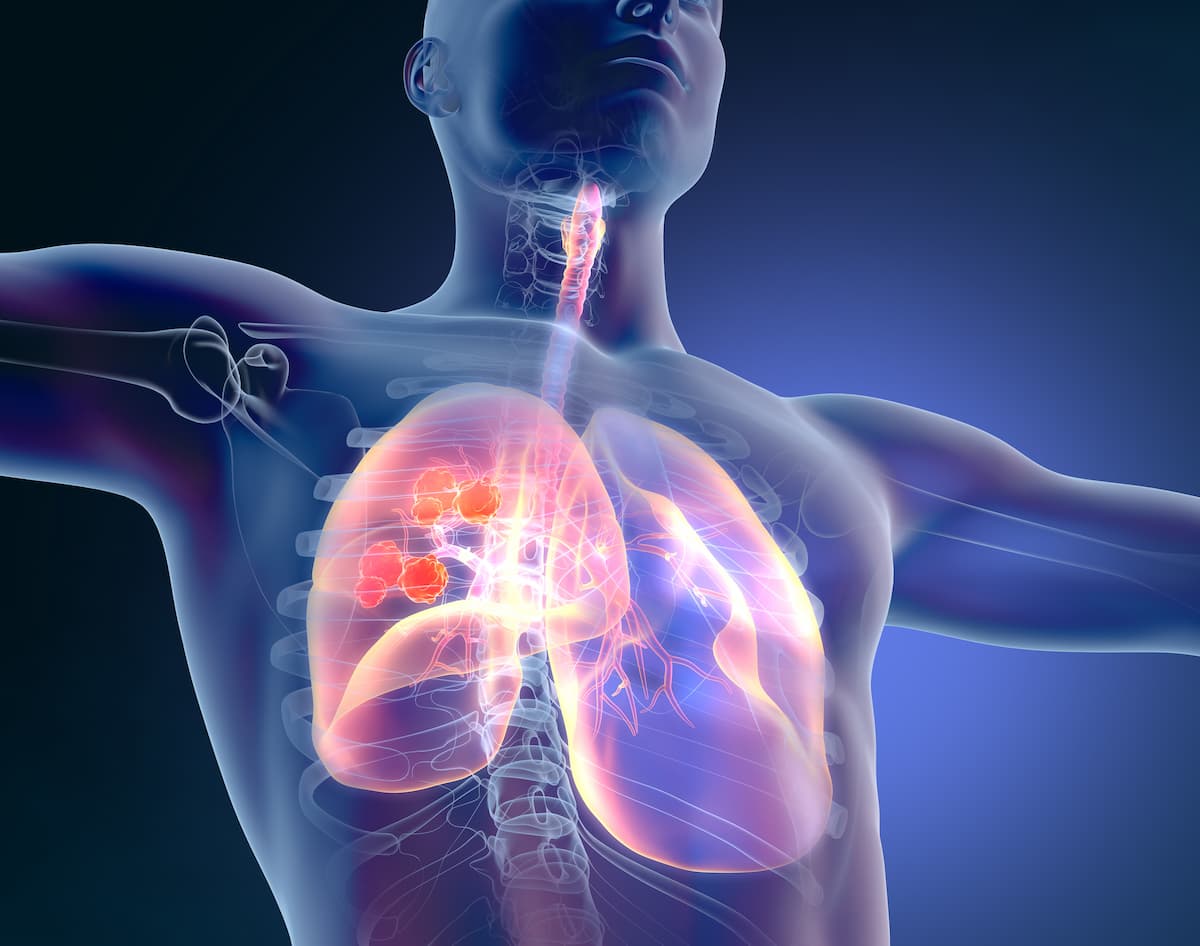Anlotinib/Irinotecan Shows Promise, Durable Responses in ES-SCLC
Patients with extensive-stage small cell lung cancer experienced a median PFS and OS of 4.5 months and 7.2 months, respectively, with anlotinib plus irinotecan.
Patients with extensive-stage small cell lung cancer experienced a median PFS and OS of 4.5 months and 7.2 months, respectively, with anlotinib plus irinotecan.

Combining anlotinib and irinotecan as second-line treatment demonstrated promising efficacy and manageable toxicity in patients with extensive-stage small cell lung cancer (ES-SCLC) who experienced relapse within 6 months after frontline therapy, according to findings from a phase 2 trial (NCT04757779) published in Lung Cancer.
In the 37 patients evaluable for efficacy and safety, the overall response rate (ORR) was 62.2% (n = 23 of 37; 95% CI, 44.8%-77.5%) and the disease control rate (DCR) was 91.9% (n = 34 of 37). Furthermore, the median progression-free survival (PFS) was 4.5 months (95% CI, 3.5-5.6) and the median overall survival (OS) was 7.2 months (95% CI, 5.9-10.1).
Subgroup analyses showed that in the 11 patients who had a chemotherapy-free interval (CTFI) of more than 3 months but less than or equal to 6 months, the ORR was 54.5% (95% CI, 23.4%-83.3%) and the DCR was 90.9%. In the remaining 26 patients who had a CTFI of 3 months or less, the ORR was 65.4% (95% CI, 44.3%-82.8%) and the DCR was 92.3%.
In the group of patients with a CTFI of more than 3 months but less than or equal to 6 months, the median PFS was 6.5 months (95% CI, 4.5-not reached [NR]) vs 3.9 months (95% CI, 3.3-5.1) in the group with a CTFI of 3 months or less (HR, 2.32; 95% CI, 1.22-4.42; P = .007); the median OS was 18.5 months (95% CI, 9.5-NR) vs 5.9 months (95% CI, 5.2-8.3), respectively (HR, 2.95; 95% CI, 1.47-5.95; P < .001).
It was noted that in those with a CTFI of more than 3 months but less than or equal to 6 months, a “promising” number of durable responses was observed and 3 patients in the complete response and partial response group had a duration of response of 6 months or more.
In patients with first-line platinum-based chemotherapy, the median PFS was 4.4 months (95% CI, 3.4-5.7) vs 4.9 months (95% CI, 3.4-not available [NA]) in those who received first-line platinum-based chemotherapy combined with immunotherapy (HR, 0.75; 95% CI, 0.39-1.45; P = .38); the median OS was 7.2 months (95% CI, 5.2-10.1) vs 8.3 months (95% CI, 5.9-NA), respectively (HR, 0.91; 95% CI, 0.43-1.89; P = .79).
“Recently, the combination of an antiangiogenic drug with other anticancer agents has garnered increasing attention as a potential therapeutic strategy,” wrote lead study author Minna Zhang, of the Department of Thoracic Oncology at Hangzhou Cancer Hospital in China, and coauthors in the paper. “Our findings provide a manageable and feasible treatment strategy for [patients with] ES-SCLC who have undergone standard first-line therapy.”
The trial enrolled a total of 37 patients, all of whom received 12 mg of oral anlotinib once daily following a schedule of 2 weeks on and 1 week off, with adjustments to 10 mg or 8 mg depending on patient tolerance, and 65 mg/m2 of irinotecan on days 1 and 8 every 3 weeks. The combination therapy lasted up to 4 cycles, and then anlotinib was continued until the occurrence of disease progression, the emergence of intolerable toxicity, or the withdrawal of consent.
Eligible patients were aged 18 and 75 years with a histologically or cytologically confirmed diagnosis of ES-SCLC who exhibited definitive radiographic evidence of disease progression within 6 months following first-line standard platinum-based chemotherapy. Patients also had an ECOG performance status of 0 to 2, a minimum expected survival duration of 3 months, and at least 1 measurable lesion per RECIST v1.1 criteria.
Exclusion criteria included tumor lesions smaller than 5 mm or those with tumor invading important blood vessels, risk of substantial bleeding during the follow-up period, and obvious pulmonary cavity or necrotic tumor.
The trial’s primary end point was ORR. Secondary end points were DCR, PFS, and OS.
Of the 37 enrolled patients, 32 had died by the data cutoff date of November 15, 2023, with the remaining 5 having developed disease progression. Regarding safety, 94.6% of patients experienced any-grade treatment-related adverse effects (TRAEs). The most common grade 1 and 2 TRAEs were fatigue (54.1%), anorexia (37.8%), and anemia (24.3%). Grade 3 TRAEs were observed in 8.1% of patients, including leukopenia (5.4%), thrombocytopenia (5.4%), anemia (2.7%), and hyponatremia (2.7%). No grade 5 TRAEs were observed.
Two patients experienced irinotecan dose reductions due to grade 3 leukopenia and anemia, and 20 patients experienced anlotinib dose reductions due to grade 3 hypertension and hyponatremia, among other reasons.
“This study further strengthens the evidence supporting the use of an antiangiogenic drug plus chemotherapy as second-line treatment for ES-SCLC,” concluded the authors.
Reference
Zhang M, Tang Y, Liang J, et al. Combination of anlotinib and irinotecan as second-line therapy in extensive-stage small-cell lung cancer relapsed within six months: a single-arm phase II study. Lung Cancer. 2025;205:108630. doi:10.1016/j.lungcan.2025.108630